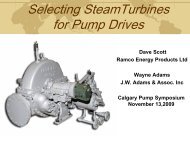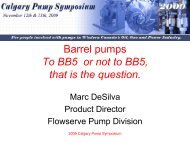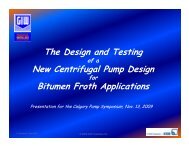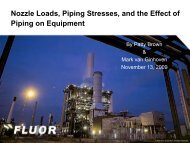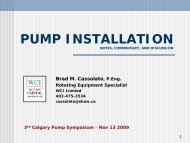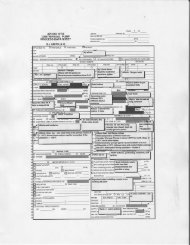Weird and Wonderful Pump Failures - Calgary Pump Symposium
Weird and Wonderful Pump Failures - Calgary Pump Symposium
Weird and Wonderful Pump Failures - Calgary Pump Symposium
You also want an ePaper? Increase the reach of your titles
YUMPU automatically turns print PDFs into web optimized ePapers that Google loves.
<strong>Weird</strong> <strong>and</strong> <strong>Wonderful</strong> <strong>Pump</strong><br />
<strong>Failures</strong><br />
Or:<br />
It was not so wonderful at the time but I did<br />
learn something.
Topics<br />
1. Reactor Feed <strong>Pump</strong>s<br />
2. Wash Water <strong>Pump</strong>s<br />
3. Amine <strong>Pump</strong>s<br />
4. Fertilizer Plant pump<br />
5. Sulphur Transfer <strong>Pump</strong><br />
6. Stripper Sour Water <strong>Pump</strong><br />
7. Low Flow Recirculation<br />
8. Foreign Objects
1: Reactor Feed <strong>Pump</strong>s<br />
o<br />
o<br />
o<br />
o<br />
o<br />
o<br />
Three 100% pumps, two are steam drive, one is electric drive.<br />
Typically the steam drives are running (1 per train) with<br />
electric drive on st<strong>and</strong>-by.<br />
<strong>Pump</strong>s are 8 stage 3” IJ’s, BB5 design<br />
Single bellows style seal with SC rotating face, TC stationary<br />
face,<br />
Plan 32 seal flush (66 °C gas oil) <strong>and</strong> Plan 62 steam quench<br />
Tilt pad axial <strong>and</strong> radial bearings, full vibration probe suite
14.6 ft
Reactor Feed <strong>Pump</strong>s<br />
o 1304 KW at 5600 rpm<br />
o Rated Flow: 140 m3/hr (616 gpm)<br />
o Rated Head: 2201 m (7221 ft)<br />
o Discharge Pressure: 20,021 kPag (2903 psig)<br />
o Normal temperature: 232 C (450 F)<br />
o Max. Temperature: 288 C (550 F)<br />
o NPSHa: 13 m (42 ft)<br />
o NPSHr: 11 m (36 ft)<br />
o Material class is API A-8 (316 AUS) but case is carbon steel<br />
with 316L cladding
Reactor Feed <strong>Pump</strong>s<br />
3000<br />
NOTE FLAT SLOPE<br />
HEAD <strong>and</strong> PWR<br />
2500<br />
2000<br />
1500<br />
1000<br />
Min. Flow<br />
Rated Point<br />
500<br />
0<br />
0 20 40 60 80 100 120 140 160 180 200<br />
FLow (m3/hr)<br />
HEAD (m)<br />
PWR (kW)
Start-up <strong>and</strong> Operation issues:<br />
o<br />
o<br />
o<br />
When units are started for the first time (at minimum flow)<br />
the vibration levels <strong>and</strong> performance are acceptable.<br />
But after being in service for a couple of weeks one of the<br />
units goes down on high vibration.<br />
Teardown shows rubbing damage to wear-rings <strong>and</strong> balance<br />
bushing, some loose case wear rings, <strong>and</strong><br />
movement of the 7’th stage impeller away from suction then<br />
back towards suction into the diffuser ring.
Back of 7’th stage impeller <strong>and</strong> 7’th stage<br />
diffuser
Start-up <strong>and</strong> Operation issues:<br />
o<br />
o<br />
o<br />
Initial failure is thought to be due to breakdown of the wearring<br />
material <strong>and</strong> internal rubs caused by poor warm-up<br />
procedures, hot misalignment, <strong>and</strong> cavitation.<br />
This leads to a great deal of work doing hot alignment <strong>and</strong><br />
base deflection measurements with lasers, baseplate grouting<br />
repairs, warm-up piping <strong>and</strong> procedures mod’s etc.<br />
The initial failed unit is re-built with the wear ring coatings<br />
applied using a different process <strong>and</strong> the Operations staff are<br />
told to monitor/control the warm-up process better.
Start-up <strong>and</strong> Operation issues:<br />
o<br />
o<br />
There are more failures of a similar nature…..even on the first<br />
unit with the repaired base-pad, the tighter warm-up controls<br />
<strong>and</strong> more accurate hot alignment.<br />
Other issues with the units are discovered<br />
• Seal failures due to poor balancing of seal flush rates to<br />
each end of the machine…the piping gets changed.<br />
• More insulation is added to the casing, balance line loop<br />
<strong>and</strong> warm-up piping to prevent blockage.<br />
• Modifications to warm-up piping are proposed to improve<br />
flow control when units are cold but never implemented.
Start-up <strong>and</strong> Operation issues:<br />
o<br />
• Seal face damage due to wet quench steam flashing inside<br />
the seal. Additional steam traps are added.<br />
• The anti-rotation keys at each case ring are increased in<br />
length to positively clamp the rings in place axially.<br />
• Lube oil water contamination caused by steam leaking<br />
from the turbine gl<strong>and</strong>s (2-3 gallons/day) fixed by<br />
installing In-Pro seals on the bearing housings.<br />
After a few more failures, sometimes 7’th stage, sometimes<br />
8’th stage we finally started to zero-in on the main failure<br />
cause…..
Start-up <strong>and</strong> Operation issues:<br />
o<br />
The minimum flow control system<br />
• During normal operation the closed minimum flow valve<br />
would cool off <strong>and</strong> not open properly when forward flow<br />
to the process was cut back at the fired heater.<br />
• The small filters in the pump discharge flow meter purge<br />
oil system would continually plug up taking the flow<br />
meter off-line or make the measurement in-accurate. The<br />
operators had to manually control the min-flow valve with<br />
absolutely no information as to the actual pump flow rate.<br />
• The pump discharge pressure at less than min-flow was<br />
enough to force the min-flow valve closed. The actuator<br />
was not sized big enough to keep the valve open!
Summary<br />
o<br />
o<br />
o<br />
We got caught up believing the drop in flow was caused by<br />
damage in the pump when it was actually the other way<br />
round….the drop in flow (dead-heading) was causing the<br />
pump damage.<br />
When the min-flow control system was fixed the pump<br />
reliability went way up.<br />
Keep going back to the physical evidence….the backward<br />
moving impellers should have focused us to a hydraulic<br />
cause.
2: Wash Water <strong>Pump</strong>s<br />
o<br />
o<br />
o<br />
o<br />
o<br />
o<br />
Three 100% pumps, One for each train, one spare.<br />
Electric drive with gearbox reduction to 203 rpm<br />
<strong>Pump</strong>s are 3 3/8 X 6 VTEM vertical triplex recips<br />
Class S-1 design, sour specification for fluid end<br />
Sleeve bearings, forged crank, aux lube oil system<br />
Two amine pumps are similar design but different operating<br />
speed.
Wash Water <strong>Pump</strong>s<br />
o 300 hp at 203 rpm<br />
o Rated Flow: 30.5 m3/hr (616 gpm)<br />
o Suction Pressure: 340 kPag (49 psi)<br />
o Discharge Pressure: 18,453 kPag (2676 psig)<br />
o Normal temperature: 95 C (203 F)<br />
o Max. Temperature: 98 C (208 F)<br />
o<br />
o<br />
NPSHa: 27 m (88 ft)<br />
NPSHr: 15 m (49 ft)
Wash Water <strong>Pump</strong>s<br />
o Numerous issues from day 1<br />
• Packing leaks due to poor<br />
plunger <strong>and</strong> push rod<br />
alignment<br />
• Poor valve life<br />
• Broken crankshafts due to<br />
fatigue initiating at hotshort<br />
tears in forging<br />
• Cracked fluid head<br />
allowing water into<br />
crankcase
Wash Water <strong>Pump</strong>s<br />
o<br />
Failure of forged pressure head
Wash Water <strong>Pump</strong>s<br />
o Failure of forged pressure head
Wash Water <strong>Pump</strong>s<br />
o<br />
o<br />
Major review conducted of operating history <strong>and</strong><br />
head design including FEA by OEM<br />
Fortunately we had lots of pressure data due to valve<br />
performance <strong>and</strong> cavitation studies.
Wash Water <strong>Pump</strong>s<br />
o<br />
o<br />
o<br />
Results of studies show that pump should be<br />
safe from fatigue failures even at off-spec<br />
operating conditions.<br />
So why did the block fail?<br />
HINT---The FEA analysis was based on the<br />
OEM’s drawings for the head.
Wash Water <strong>Pump</strong>s<br />
o<br />
Dimensional checks of the failed head showed that the radius<br />
at the bottom of the suction valve pocket was smaller than<br />
design by 1/8 inch!
Wash Water <strong>Pump</strong>s<br />
o<br />
o<br />
o<br />
o<br />
Using the actual radius in the FEA model indicated<br />
that fatigue was possible.<br />
Suspect that the machinist used the wrong size tool<br />
when the suction valve pockets were being machined<br />
All similar heads on site checked… one other head<br />
had to be replaced.<br />
Considered shot-peening the radius area to improve<br />
fatigue resistance but no further failures occurred.
3: Amine <strong>Pump</strong>s
Amine <strong>Pump</strong>s<br />
o<br />
o<br />
o<br />
Lean Amine API Type BB3 pumps protected by three<br />
shutdown systems:<br />
• Low feed drum level<br />
• Low discharge pressure<br />
• High vibration<br />
Nuisance trips cause changes to controls:<br />
• The low discharge pressure SD is removed for start-up but<br />
not reinstated after start-up<br />
• The low level trip on the feed drum is tied to the pump<br />
shutdown.<br />
• High vibration SD’s changed to 2 out of 2 voting<br />
• Vibration SD set points raised<br />
No one caught that the vibration levels were set too high.
Amine <strong>Pump</strong>s<br />
o<br />
o<br />
o<br />
o<br />
o<br />
Residence time in the feed drum is very short<br />
Low level trip was lowered to 2% from 15% to prevent<br />
nuisance pump shutdowns<br />
Level transmitter sensing legs were equalized with glycol<br />
The glycol in the sensing legs became unbalanced, <strong>and</strong><br />
indicated a higher feed drum level than what there actually<br />
was <strong>and</strong> the pump ran dry<br />
Another incident elsewhere in the plant took the operators<br />
attention away from operating the plant to shutting the plant<br />
down
Amine <strong>Pump</strong>s<br />
o<br />
o<br />
o<br />
o<br />
o<br />
Outside operator attempted to shut down the operating pump<br />
because it was “making noise”<br />
The control system auto-starts the second pump <strong>and</strong> shortly<br />
thereafter it starts making a loud noise too.<br />
Vibration instruments did not shut the pumps down.<br />
“Pinning out” the local start button successfully stopped these<br />
pumps.<br />
Remarkably, both pumps were still capable of moving liquid<br />
when drum level was restored.
First rotor, 1’st stage impeller warped <strong>and</strong><br />
cracked
First rotor, 2’nd stage impeller thrust<br />
damage
First rotor, general condition of the<br />
case
Second rotor, 2’nd stage impeller thrust<br />
damage, broken wear rings
Second case, bottom half wear ring l<strong>and</strong><br />
damage
Second rotor, impeller keyway damage
Amine <strong>Pump</strong>s<br />
Removal <strong>and</strong> repairs began within 2 days.<br />
<strong>Pump</strong>s were repaired in t<strong>and</strong>em utilizing two repair shops,<br />
both shops working 24 hours per day.<br />
Extensive weld repairs needed for cases <strong>and</strong> impellers<br />
New shafts, wear rings, <strong>and</strong> bearings installed<br />
A temporary 14 stage rental pump was installed in case there<br />
was an issue with any of the repaired pumps. Skid pump was<br />
never operated.<br />
<strong>Pump</strong> repair was 16 days stream to stream<br />
Rental pump installation was completed in 14 days.<br />
AN AMAZING AMOUNT OF WORK IN A SHORT TIME<br />
o<br />
o<br />
o<br />
o<br />
o<br />
o<br />
o
Rental pump installation
Rental pump installation is ready for<br />
service
4: Fertilizer Plant<br />
o<br />
o<br />
o<br />
1,500 hp double suction pump running at<br />
3,600 rpm. Double volute<br />
<strong>Pump</strong> design used extensively in Europe with<br />
very good reliability in similar service<br />
Original impeller is 6 vane design<br />
o Impeller <strong>and</strong>/or shaft failure approx every 6<br />
months
Impeller Damage
Fertilizer Plant<br />
o<br />
o<br />
o<br />
Change to 6 staggered vanes <strong>and</strong> very large radius on keyway<br />
under impeller ….increased life to approx 4 years<br />
Further change to 7 vane staggered <strong>and</strong> profiled case<br />
cutwaters …. problem has basically gone away.<br />
Thoughts on the service/pump:<br />
• very high energy pump<br />
• 6 vanes <strong>and</strong> double cutwater, a common European design,<br />
often leads to very large pressure pulsations<br />
• pump initially designed <strong>and</strong> checked for 50 Hz power<br />
(3000 rpm) but not for 60 Hz (3600 rpm)
5: Sulphur Transfer <strong>Pump</strong><br />
o<br />
o<br />
o<br />
Two vertical centrifugal VS4 style pumps installed in vessel.<br />
“A” pump top bearing deterioration detected by periodic<br />
vibration monitoring<br />
Switched to st<strong>and</strong>-by “B” pump but very little flow<br />
developed. “B” unit had not been operated for 12 months
Sulphur Transfer <strong>Pump</strong><br />
o<br />
o<br />
Pulled “B” pump <strong>and</strong> found extensive blockage due to chunks<br />
of 3/8 to 3/4 inch sulphurcrete in the impeller <strong>and</strong> suction.<br />
The original strainer was designed with maximum perforation<br />
of 1”.
Sulphur Transfer <strong>Pump</strong><br />
o<br />
o<br />
o<br />
o<br />
Raise the pump suction 3 feet by<br />
shortening the column<br />
increase the normal liquid level in<br />
vessel to 20% to maintain NPSHa<br />
at required value.<br />
pump strainer re-designed to block<br />
particles larger than 3/8”<br />
Operating procedure put in place to<br />
switch pumps on a fixed schedule
6: Stripper Sour Water <strong>Pump</strong><br />
o<br />
Corrosion found on 4140 shaft near stuffing box <strong>and</strong><br />
on case wear ring seats of the A216 casing halves
Stripper Sour Water <strong>Pump</strong><br />
o<br />
o<br />
o<br />
Corrosion mechanism is probably related to<br />
selenium concentration…not normally expected in<br />
this process.<br />
Suspect that upstream oil s<strong>and</strong> feed is responsible<br />
Upgraded the shaft components as follows:<br />
• – Base material to 12Cr.<br />
• – HVOF coated
7: Low Flow Re-circulation<br />
o<br />
o<br />
o<br />
o<br />
o<br />
Ansi 1 X 2 -10 condensate pump<br />
2 years of operation at high head – low flow<br />
2 thrust bearing failures in 2 years<br />
Pulled impeller <strong>and</strong> found ¼ inch metal loss<br />
due to improper adjustment<br />
Strong evidence of discharge recirculation
Low Flow Recirculation
Low Flow Recirculation
8: Foreign objects
Foreign objects
Comment<br />
o<br />
o<br />
Some say failure analysis is easier now because of the sophisticated data<br />
collection <strong>and</strong> trending tools we have.<br />
To this I say ……
Comment<br />
o<br />
o<br />
Some say it is failure analysis is easier now because of the sophisticated data<br />
collection <strong>and</strong> trending tools we have.<br />
To this I say ……
My thanks to:<br />
o<br />
Chris Gilmour<br />
o<br />
Jim Dziadyk<br />
o<br />
C. Dale Alleyne<br />
o<br />
Frank DiRocco<br />
o<br />
Brad Hatton<br />
o<br />
John Hogan<br />
o<br />
Scott Masterson<br />
o<br />
Gordon Lawrence<br />
o<br />
Matt Pickard<br />
o<br />
David Goddard<br />
o<br />
Hector J. Amaya<br />
for providing pictures<br />
<strong>and</strong> information for<br />
this presentation!



